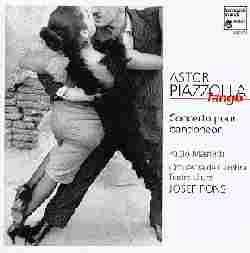
Program:

Program:
Concierto para bandoneon, orquestra de
cuerdas y percusion (1979)
Tres movimientos tanguisticos portenos (1968)
Tangos (arr. Lluis Vidal)
Total Time: 67:26
Released in 1996
label:
harmonia mundi(HMC 901595)
Mas de Vert
13200 Arles
France
in USA:
2037 Granville Ave.
Los
Angeles, CA 90025-6103
Tel. 310-478-1311
Fax.
310-996-1389
Review by Henry Doktorski:
Then in Buenos Aires around 1955, Piazzolla discovered his unique voice and coined the term Nuevo Tango -- a synthesis of classical music, jazz and the tango -- which, at first, earned him the bewilderment and the visceral rejection of the intelligentsia tanguistica. After years of struggle, the world finally began to recognize his genius and he was rewarded with many joyful encounters with great performers such as Gerry Mulligan and Gary Burton in jazz, Lalo Shiffrin and the Orchestre du Capitole de Toulouse in classical music, the Kronos Quartet in the avant garde, and the film director Fernando Solanas and the composer Horacio Ferrer. Piazzolla wrote over 750 compositions, including concerti, operas, film and theater scores, and recorded over 70 records.
Piazzolla's Concerto for Bandoneon and String Orchestra and Percussion
is considered one of his greatest works. It was commissioned by the Banco
de la Provinicia of Buenos Aires for a radio broadcasting event in 1979.
The concerto has a strong external resemblance to the Baroque concerto
grosso and thus has a classical form. The bandoneon -- certainly an
emotional instrument -- sings, laments and at times cries out in a torment
of alienation.
In Tres movimientos tanguisticos portenos -- another major
work by Piazzolla -- the bandoneon -- Piazzolla's instrument of choice --
is conspicuously absent, but this is balanced by the remarkable
orchestration which is extremely rich and colorful. The haunting clarinet
melody accompanied by pizzicato strings and high percussion at the end of
the first movement is striking. The second movement features a delightful
cadenza consisting of a duet between the bassoon and bass clarinet. Of
special interest to classical music lovers is the fugue at the beginning
of the third movement.
The five tangos which complete the album (arranged by pianist Lluis
Vidal) are a welcome contrast to the first two lengthly and serious works.
The Orquestra de Cambra Teatre Lliure under Josep Pons' direction is
driving at times, melancholy at other times, but always clear and
well-defined. Mainetti's bandoneon playing is convincing and I dare say
that I believe that the late Astor Piazzolla would be pleased with this
recording.
Bandoneonist Pablo Mainetti was born in Buenos Aires and completed his
studies in bandoneon, harmony and composition before specializing in
chamber and contemporary music. He has worked under the direction of Beba
Pugliese, Nestor Marconi, Daniel Binelli, Mederos and Rodolfo Alchurron.
He has performed in festivals such as the Tangos por dos of Juan Carlos
Copas, the Spanish-American Encounters of Bogota, the Cervantino and Tango
festivals of Granad, The Barcelona Tango Festival, the Argentia Week and
the Universal Exhibition in Lisbon.
The CD booklet notes by Francisco Cruz are written in French, English,
German and Spanish. I recommend this album for lovers of Piazzolla, nuevo
tango and the bandoneon.
| About The Free-Reed Review |
| Invitation to Contributors / Submission Guidelines |
| Back to The Free-Reed Review Contents
Page |
| Back
to The Classical Free-Reed, Inc. Home Page |